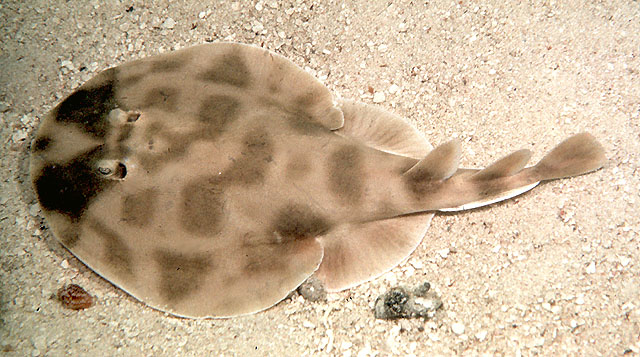| Narcinidae (Numbfishes) |
| 54 cm WD (male/unsexed); max.weight: 650.0 g |
|
reef-associated; marine; depth range 1 - 43 m |
| Western Atlantic: Espirito Santo, Brazil to northern Argentina (Carvalho, pers. comm.). North Carolina, USA to Florida, northern Gulf of Mexico, central Lesser Antilles and Yucatan (Ref. 26938). |
|
A pale sand-colored ray, often with ellipses of dark spots on dorsal side of rounded disk (Ref. 26938). Grayish to reddish brown, many rounded blotches outlined with blackish spots. Dark bands across tail up to dorsal fin. Snout darkened (Ref. 7251). |
| Inhabits coastal waters, on sand or mud bottoms (Ref. 26340). Common along sandy shorelines, sometimes near coral reefs (Ref. 12951). Aggregates in shallow waters ca. 10-20 m deep during summer and autumn months, dispersing to deeper waters during winter (Ref. 114953). Buries itself with only eyes protruding (Ref. 12951). Nocturnal, moves to shallow bays at night to feed; prefers worms, but may take juvenile snake eels, anemones, and, small crustaceans (Ref. 12951). Produces broods of 4 to 15 young (Ref. 26938). Reaches ca. 45 cm TL. Both sexes mature by 27 cm TL; birth size at ca. 11 cm TL (Ref. 114953). Can discharge between 14 and 37 volts. Contact with the skin can produce a severe electric shock. In addition to the main electric organ, this species possesses a bilateral accessory electric organ (Ref. 10011) speculated to have a possible role in social communication (Ref. 10489). Reported to taste good, but not fished commercially. Traded as an aquarium fish at Ceará, Brazil (Ref. 49392). |
|
Near Threatened (NT); Date assessed: 01 July 2019 (A2d) Ref. (130435)
|
| other |
Source and more info: www.fishbase.org. For personal, classroom, and other internal use only. Not for publication.

